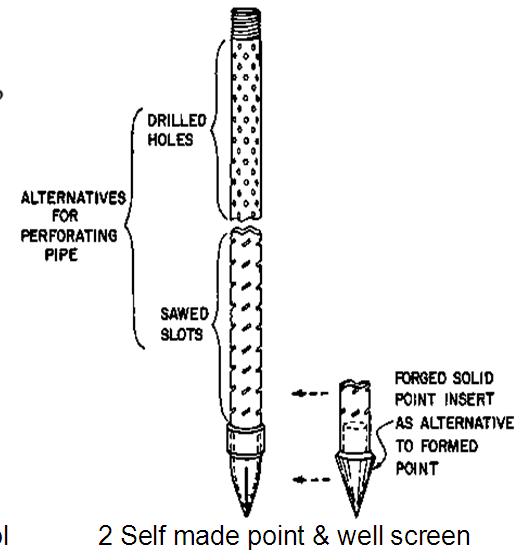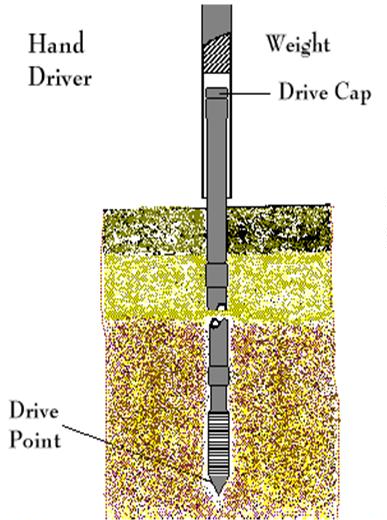Hand auger - driven wells
The driven well consists of a pointed perforated or slotted pipe or a pipe with a pointed well screen attached which has been driven into an aquifer. The pipe with pointed well screen is driven into place in much the same way a nail is driven into wood. The material is forced aside rather than excavated by this technique. Normally special pipe with thick walls and specially designed couplings are used to resist the driving forces. The pipe is driven into the ground using a hammering tool or a normal hammer.
Driven wells are sometimes used in combination with augers in collapsing sand layers. If augers cannot penetrate further into a collapsing sand layer, and a temporary casing cannot be used (for example, the casing is stuck in a clay layer), a well point and well screen can be driven into the ground using a hammering tool or normal hammer.
Suitable conditions
The driven well can only achieve a penetration of only 1-2 meters into the water table because of the compacting resistance of the sand. The depth can be increased to about 10 meters using an engine driven power tool. However, the type of formation (of the aquifer, permeable or not permeable) can not be determined at this depth because no soil samples can be taken. This may affect the well yield. It is not possible to install a gravel pack around the well screen.
| Advantages | Disadvantages |
|---|---|
| - The driven well can be used in combination with augers in collapsing sand layers. |
- The driven well can only achieve penetration of 1-2 meters into the water table |
Construction, operations and maintenance
Driven wells are sometimes used in combination with augers in collapsing sand layers. If augers cannot penetrate further into a collapsing sand layer, and a temporary casing cannot be used (for example, the casing is stuck in a clay layer, see description above), a well point and well screen can be driven into the ground using a hammering tool or normal hammer.
Well points and well screens can be self or factory made.
Field experiences
Driven wells are mainly used in Chad, Cameroon and Madagascar
Reference manuals, videos, and links
- KOEGEL, R. (1985) Self Help Wells, FAO Irrigation and Drainage Paper, FAO, Rome.ISBN 92-5-100398-X html version.
- Water for the World, Technical note series rws 2, USAID 1982 - Technical notes on methods of developing of groundwater, manual drilling techniques. Website Livewater International.
- Multi-service procedures for well-drilling operations, field manual chapter 9, US Military Chapter 9 (sec. 9.3), alternative well construction, manual drilling techniques - Download.
- Rural Water Supply Network - Useful network and website for information and downloads related to Rural Water Technologies - short information on driven wells
Acknowledgements
- The basis for the material on this page was obtained from a desk study shortly to be published on the website of the Practica Foundation, and from the Rural Water Supply Network, and specifically its manual drilling section.
- 43. Simple drilling methods. WEDC.



